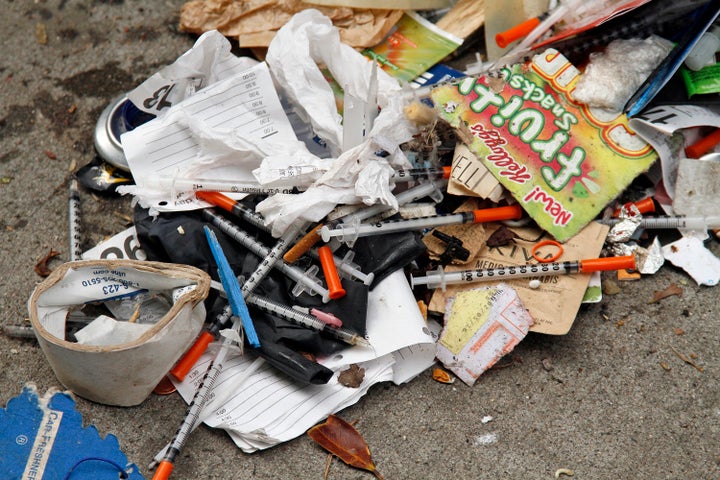
Starbucks employees are worried about the danger of being stuck with used syringes discarded in store bathrooms.
More than 3,700 people had signed a petition requesting safe syringe disposal in the stores’ bathrooms as of Friday. The petition cited fear of exposure to infectious diseases like HIV, hepatitis C and hepatitis B, should a Starbucks employee accidentally come in contact with a used needle while cleaning the bathroom or emptying the trash — something multiple employees have reported happening.
Starbucks installed safe syringe disposal boxes in all of its Seattle stores last year, and is now responding to employee concerns by exploring rolling them out to more locations.
“At the end of the day, we want to make sure that our partners are safe,” Starbucks spokesperson Reggie Borges said. “I don’t think this is a problem unique to Starbucks,” he added. “I think a lot of retail business are dealing with this.”
Dr. Alysse Wurcel, an attending infectious disease physician at Tufts Medical Center, praised the needle-disposal box rollout, saying she “absolutely” thinks there should be needle boxes in the stores’ bathrooms.
“The people working at Starbucks didn’t go into this job thinking of these health exposure risks,” said Wurcel, whose job includes responding to alerts that a patient might have been exposed to an infectious disease from a discarded needle.
While the boxes will undoubtedly help Starbucks employees to feel safer at work, health experts say the risk of contracting those diseases from an accidental needle poke is low.
“In medical school, we were taught that it’s the law of threes,” said Dr. Joshua Barocas, an assistant professor at the Boston University School of Medicine.
An unvaccinated person who is stuck with a contaminated syringe would have a 30 percent chance of contracting hepatitis B, a 3 percent chance of contracting hepatitis C and a 0.3 percent chance of contracting HIV, he explained.
And even those figures come with caveats, Barocas noted. “HIV notoriously does not survive outside of the body for very long,” he said. “It doesn’t hang out on needles.”
Hepatitis C virus, which is about 10 times more infectious than HIV, survives longer outside of the body.
In the case of either virus, however, immediate exposure to a contaminated syringe ― from sharing needles while injecting drugs, for example ― poses a greater risk than coming in contact with a needle that’s been sitting in a trash can.
The law of threes estimates are “based on hospital needlestick data where the blood is fresh,” said Robert Heimer, a professor of epidemiology at the Yale School of Public Health. Unlike when intravenous drug users share needles, the average person won’t immediately come in contact with a discarded syringe.
“There is no measurable risk,“ Heimer concluded about encountering a used needle in a coffee shop bathroom long after it was discarded.
“While infectious HIV and [hepatitis C] can be recovered from inside the barrel of syringe, the amount on the outside is minuscule,” he said. “Even if there is any, the virus is likely to be quickly inactivated.”
“It’s sad that we have to have people injecting in bathrooms. It’s a symptom of a larger problem.”
- Dr. Alysse Wurcel, an attending infectious disease physician at Tufts Medical Center
Minuscule or not, Dan Ciccarone, professor of family and community medicine at the University of California, San Francisco said he thinks the risk of accidental exposure is real.
Ciccarone said he was concerned about both hepatitis C and HIV at a population level, noting that “accidents happen along the way.”
“The only argument against [sharps boxes] is that HIV and hepatitis C are under control,” he said. That’s not necessarily the case.
New hepatitis C cases more than tripled between 2010 and 2016, with an estimated 41,000 new cases occurring in 2016 alone. Most of those new infections were linked to injection drug use, according to the Centers for Disease Control and Prevention. And HIV outbreaks linked to injection drug use in Massachusetts last year and in Scott County, Indiana, a few years prior, are signs that HIV still has the potential to return in places where risk factors like injection drug use, fentanyl prevalence and lack of health services align.
Barocas stressed the value of sharps containers in making workers feel protected by their employers. “If an employee feels like this is a safety issue, then there is no downside,” he said.
Beyond immediate concerns about employee safety, the wider public health context of used needles in retail bathrooms is that people who use drugs are turning to Starbucks because they don’t have a safe place to inject or dispose of used needles.
“It’s sad that we have to have people injecting in bathrooms,” Wurcel said. “It’s a symptom of a larger problem.”
In general, if someone is accidentally pricked by a needle, they should go to the emergency department or call their doctor to assess their risk of infection. Depending on the situation, a health care professional can help determine whether further treatment, like testing or post-exposure medication, is needed. For used needles spotted on the ground, people should call public works or the police department about proper disposal, or the facility management of whatever space they are in.
“If there’s one needle, then there are likely more, so a larger local government clean up effort might be needed,” Barocas said.
